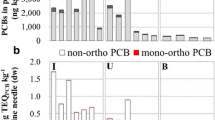Abstract
In this study, pine needles were used as cost-effective and reliable passive bio-monitors to concomitantly evaluate atmospheric concentrations of three classes of persistent organic pollutants, polychlorinated biphenyls (PCBs), organochlorine pesticides (OCPs), and polycyclic aromatic hydrocarbons (PAHs). The extraction of persistent organic pollutants (POPs) from needle samples was performed. Eleven PCBs, 11 OCPs, and 15 PAHs were detected and followed through time in needle samples from three sites in the Strasbourg region. The urban and rural sites were more exposed to PCBs than the suburban site. The highest concentration of PCBs was found at the urban site, but the largest number of congeners (10) was detected at the rural site. PCB 189 and 156 were the predominant congeners in the rural site and PCB 70 in the urban site. For OCPs, the rural site displayed the highest concentrations (up to 22.9 ng g−1) and number of compounds investigated (9). The high concentration of γ- and β-hexachlorocyclohexane (HCH) at that time in the urban site was the reason for this result. γ- and β-HCH were the two predominant compounds in all samples. The suburban and urban sites were the most exposed with PAHs with pyrene, phenanthrene, and acenaphthene being the three predominant compounds in these sites. No specific trend in terms of time was apparent for PCBs and OCPs. However, higher concentrations were detected for some compounds in the first sampling, especially for PAHs, and this is attributed to variations in meteorological conditions (e.g., temperature, wind, rain) and variable inputs from both identified and unidentified sources.






Similar content being viewed by others
References
Amigo JM, Ratola N, Alves A (2011) Study of geographical trends of polycyclic aromatic hydrocarbons using pine needles. Atmos Environ 45:5988–5996
Biterna M, Voutsa D (2005) Polychlorinated biphenyls in ambient air of NW Greece and in particulate emissions. Environ Int 31:671–677
Cindoruk SS, Tasdemir Y (2007) Deposition of atmospheric particulate PCBs in suburban site of Turkey. Atmos Res 85:300–309
Getachew M (2012) Analysis of organohalogen pollutants in pine needles. Comparison of Soxhlet and Ultrasonic Extraction Methods. Master’s thesis, 49 pp
Guéguen F (2011) Caractérisation de l’impact des émissions industrielles de Strasbourg-Kehl sur l’environnement urbain et rural (prélèvement passif et biomonitoring): Etude des polluants organiques (PCBs), métaux et traçage isotopique sur les aérosols et biomoniteurs. Thèse de l’Université de Strasbourg, 284 pp
Hayward SJ, Gouin T, Wania F (2010) Comparison of four active and passive sampling techniques for pesticides in air. Environ Sci Technol 44:3410–3416
Hedman B, Näslund M, Marklund S (2006) Emission of PCDD/F, PCB, and HCB from combustion of firewood and pellets in residential stoves and boilers. Environ Sci Technol 40:4968–4975
Hinds WC (1999) Aerosol technology, properties, behavior, and measurements of airborne particles. Wiley Interscience, New York
Jones KC, de Voogt P (1999) Persistent organic pollutants (POPs): state of the science. Environ Pollut 100:209–221
Kallenborn R, Oehme M, Wynn‐Williams DD, Schlabach M, Harris J (1998) Ambient air levels and atmospheric long‐range transport of persistent organochlorines to Signy Island, Antarctica. Sci Total Environ 220:167–180
Komp P, McLachlan MS (2000) The kinetics and reversibility of the partitioning of polychlorinated biphenyls between air and ryegrass. Sci Total Environ 250:63–71
Lehndorff E, Schwark L (2004) Biomonitoring of air quality in the Cologne Conurbation using pine needles as a passive sampler—part II: polycyclic aromatic hydrocarbons (PAH). Atmos Environ 38:3793–3808
Lei X, Ran D, Lu J, Du Z, Liu Z (2013) Concentrations and distribution of organochlorine pesticides in pine needles of typical regions in Northern Xinjiang. Environ Sci Pollut Res. doi:10.1007/s11356-013-1846-z
Li YF, Cai DJ, Singh A (1998) Technical hexachlorocyclohexane use trends in China and their impact on the environment. Arch Environ Contam Toxicol 35:688–697
Lim HL, Harrison RM, Harrad S (1999) The contribution of traffic to atmospheric concentrations of polycyclic aromatic hydrocarbons. Environ Sci Technol 33:3538–3542
Morville S, Scheyer A, Mirabel P, Millet M (2004) Sampling and analysis of PAHs in urban and rural atmospheres. Spatial and geographical variations of concentrations. Polycycl Aromat Hydrocarb 24:617–634
Oishi Y (2013) Comparison of pine needles and mosses as bio-indicators for polycyclic aromatic hydrocarbons. J Environ Prot 4:106–113
Ok G, Ji S-H, Kim S-J, Kim Y-K, Park J-H, Kim Y-S, Han Y-H (2002) Monitoring of air pollution by polychlorinated dibenzo-p-dioxins and polychlorinated dibenzofurans of pine needles in Korea. Chemosphere 46:1351–1357
Ratola N, Amigo Rubio JM, Alves A (2010) Levels and sources of PAHs in selected sites from Portugal: biomonitoring with Pinus pinea and Pinus pinaster needles. Arch Environ Contam Toxicol 58:631–647
Ratola N, Alves A, Santos L, Lacorte S (2011) Pine needles as passive bio-samplers to determine polybrominated diphenyl ethers. Chemosphere 87:245–252
Ratola N, Homem V, Silva JA, Araújo R, Amigo HM, Santos L, Alves A (2014) Biomonitoring of pesticides by pine needles—chemical scoring, risk of exposure, levels and trends. Sci Total Environ 476–477:114–124
Reischl A, Reissinger M, Thoma H, Hutzinger O (1989) Uptake and accumulation of PCDD/F in terrestrial plants: basic considerations. Chemosphere 19:467–474
Romanić SH, Klinčić D (2012) Organochlorine compounds in pine needles from Croatia. Bull Environ Contam Toxicol 88:838–841
Simonich SL, Hites RA (1995) Organic pollutant accumulation in vegetation. Environ Sci Technol 29:2905–2914
Strachan WMJ, Kylin H, Eriksson G, Jensen S (1994) Organochlorine compounds in pine needles: methods and trends. Environ Toxicol Chem 13:443–451
Tomashuk TA, Truong TM, Madhavi M, McGowin AM (2012) Atmospheric aromatic hydrocarbon profiles in pine needles and particulate matter and their temporal variations in Dayton, Ohio, USA. Atmos Environ 51:196–202
Tremolada P, Burnett V, Calamari D, Jones KC (1996) A study of the spatial distribution of PCBs in the UK atmosphere using pine needles. Chemosphere 32:2189–2203
Weinberg J (2008) An NGO Guide to Persistent Organic Pollutants. A framework for action to protect human health and the environment from persistent organic pollutants (POPs), 81p
Wenzel KD, Hubert A, Manz M, Weissflog L, Engewald W, Schüürmann G (1998) Accelerated solvent extraction of semi volatile organic compounds from biomonitoring samples of pine needles and mosses. Anal Chem 70:4827–4835
Wyrzykowska B, Hanari N, Orlikowska A, Bochentin I, Rostkowski P, Falandysz J, Taniyasu S, Horii Y, Jiang Q, Yamashita N (2007) Polychlorinated biphenyls and -naphthalenes in pine needles and soil from Poland—concentrations and patterns in view of long-term environmental monitoring. Chemosphere 67:1877–1886
Acknowledgments
Financial support to the project from the CNRS for the “Zone Atelier de l’Environnement urbain de Strasbourg” (za-eus.in2p3.fr) as well as from REALISE, the Alsace network of engineering, and research laboratories for environmental sciences (realise.unistra.fr) is gratefully acknowledged.
Author information
Authors and Affiliations
Corresponding author
Additional information
Responsible editor: Constantini Samara
Rights and permissions
About this article
Cite this article
Al Dine, E.J., Mokbel, H., Elmoll, A. et al. Concomitant evaluation of atmospheric levels of polychlorinated biphenyls, organochlorine pesticides, and polycyclic aromatic hydrocarbons in Strasbourg (France) using pine needle passive samplers. Environ Sci Pollut Res 22, 17850–17859 (2015). https://doi.org/10.1007/s11356-015-5030-5
Received:
Accepted:
Published:
Issue Date:
DOI: https://doi.org/10.1007/s11356-015-5030-5




